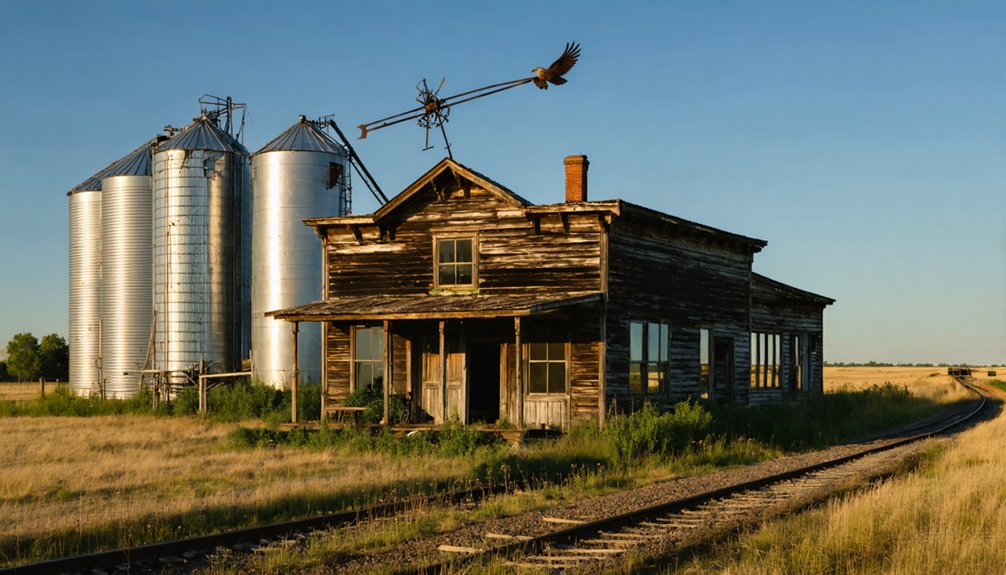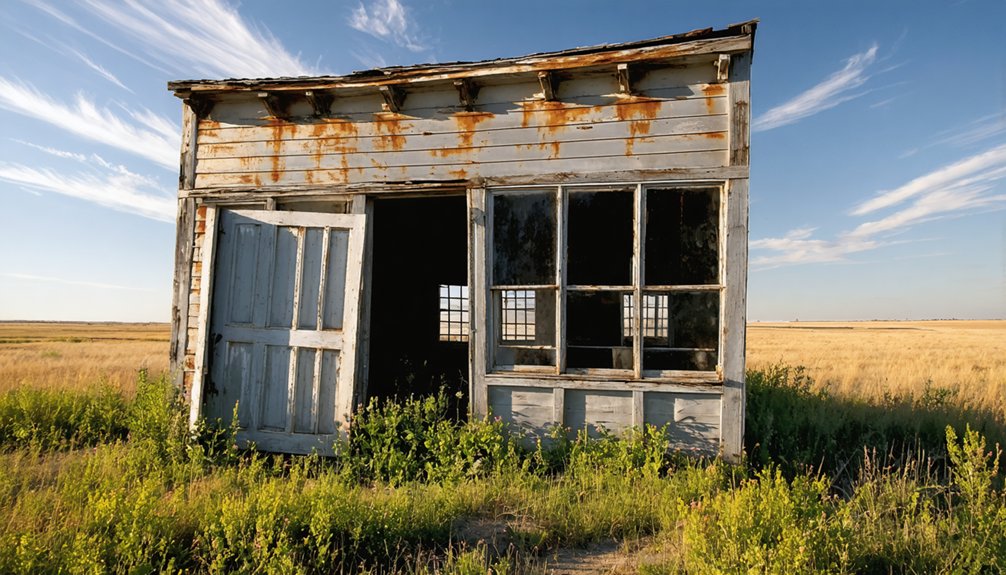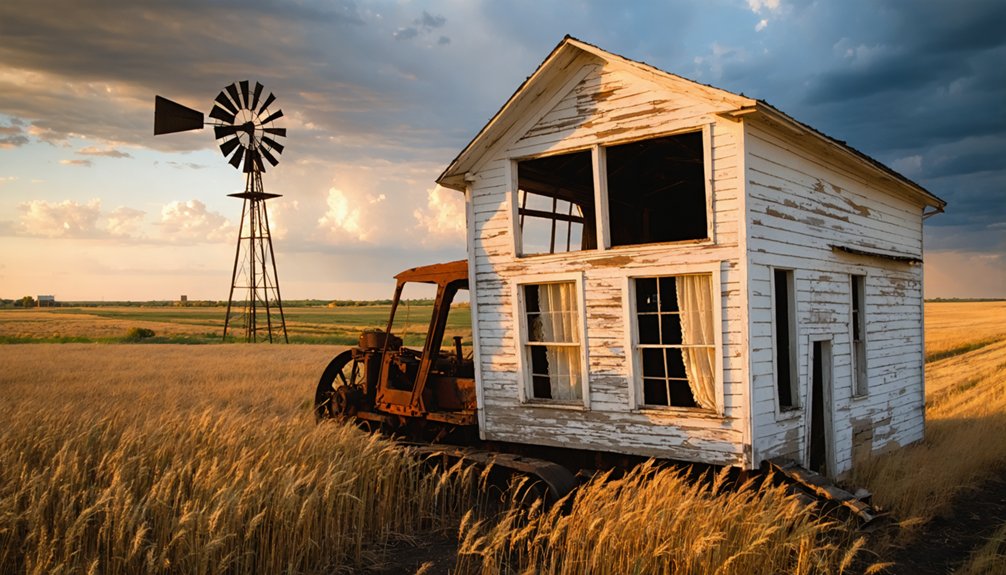You’ll find New Berlin’s ghost town site in South Dakota, where German immigrants established a frontier settlement in the late 1800s. The community centered around St. Stephan’s Church and thrived on agriculture, but faced harsh winters and economic challenges. By 1878, settlers had abandoned the town, leaving no standing structures today. The transformed pastureland reveals little of its past, though the story of this German-Russian settlement captures an important chapter in Dakota Territory’s development.
Key Takeaways
- New Berlin was established by German immigrants in late 19th century South Dakota but was completely abandoned by 1878.
- The ghost town’s location was chosen for agricultural opportunities and railroad access, though no structures remain today.
- St. Stephan’s Church served as the community’s central gathering point during the town’s brief existence.
- The site has been transformed into pastureland, with no preserved buildings, historical markers, or visible ruins remaining.
- Economic challenges, including railroad service reduction and the Great Depression, contributed to the town’s eventual abandonment.
The Origins and Settlement of New Berlin
As German immigrants pushed westward during the late 19th century, they established New Berlin as a small settlement in South Dakota’s fertile prairie lands.
The town’s founding reflected broader settlement patterns of the era, with settlers drawn to agricultural opportunities and railroad access in the Dakota Territory.
You’ll find that New Berlin’s early development centered on farming and local commerce, with immigrant influence shaping every aspect of community life.
The settlers chose the name to honor their Germanic heritage, distinguishing their new home from indigenous settlements while maintaining cultural ties to Berlin, Germany.
The modest population consisted mainly of farming families and tradesmen working the land or providing essential services to the agricultural community.
The Dust Bowl era of the 1930s ultimately contributed to the region’s widespread abandonment of similar farming settlements.
Like the town of St. Marys that would later become the Argonne settlement, New Berlin struggled to maintain its population in the challenging frontier environment.
However, the town’s promise was short-lived, as records show it was abandoned by 1878.
Life in a Frontier Prairie Town
As you walked the streets of New Berlin in its heyday, you’d find ranchers and their families battling harsh Dakota winters, water shortages, and the constant need to maintain their livestock through extreme weather conditions.
The town’s social fabric was woven through community gatherings at the local church, where holiday celebrations and weekly socials provided essential respite from isolation of ranch life. St. Stephan’s Church, with its intact 1915 structure, served as a central meeting point after being relocated from Dixon. Like other buildings in the area, it showed signs of the weathered wood that characterized authentic prairie structures.
You couldn’t predict when blizzards might force families to stay home for weeks, but these weather-driven periods of isolation strengthened community bonds as neighbors helped neighbors survive the challenging prairie conditions.
Daily Ranch Life Challenges
While frontier life in New Berlin offered independence and opportunity, daily ranch operations presented relentless challenges for settlers in the harsh South Dakota prairie.
Your daily routines would begin before sunrise, tending to livestock in extreme temperatures that could swing from blistering heat to bitter cold. You’d face constant livestock challenges, protecting your herds from predators while ensuring adequate feed and water supplies.
Breaking the tough prairie sod for crops required immense physical effort, and you’d struggle with limited mechanization for planting and harvesting. Like many South Dakota towns that relied on the grain elevator trade, maintaining and operating these vital facilities became a cornerstone of agricultural life.
When dirt roads turned impassable during wet seasons, you’d find yourself isolated, making it difficult to transport goods or access medical care. Concord stagecoaches provided essential transportation between frontier settlements, though service was often unreliable.
You’d spend countless hours maintaining buildings and fences against prairie winds, while carefully rationing water during frequent droughts.
Community Gatherings and Traditions
Despite the harsh realities of frontier life, the settlers of New Berlin found strength and solace in their vibrant community gatherings. You’d find the town’s residents congregating at the local church, which served as both a place of worship and a social hub.
Community picnics brought families together during summer months, while winter evenings were spent at communal suppers and storytelling sessions that helped ward off isolation. Just as in Rockerville’s Gaslight Restaurant, the gathering places became essential to maintaining the town’s social bonds.
The schoolhouse buzzed with activity beyond daily lessons, hosting spelling bees and holiday performances that drew the entire town. During the memorable 1952-53 season, the Argonne Arrows basketball team brought the community together with their thrilling games and victories.
When harvest season arrived, neighbors joined forces to bring in crops, celebrating afterwards with festive barn dances and shared meals.
These gatherings weren’t just social events – they formed the backbone of survival, as settlers relied on each other through collective labor and mutual support.
Weather-Shaped Social Activities
Life in New Berlin revolved around the prairie’s dramatic weather patterns, which shaped both daily routines and social gatherings throughout the year.
During harsh winters, you’d find residents gathering indoors around wood stoves for storytelling and music, seeking warmth and companionship to combat isolation. Similar to many prairie settlements, the dance halls remained a cherished part of the community’s social memory.
When summer arrived, community life flourished outdoors with picnics and children’s games lasting until dusk.
The town’s social calendar adapted to seasonal events, with harvest celebrations marking successful crop completion.
You’d see church services and local fairs carefully scheduled around weather conditions to guarantee maximum participation.
When storms disrupted planned gatherings, townspeople would quickly adjust, demonstrating the frontier spirit of flexibility.
The weather’s unpredictability made every successful social gathering more meaningful, strengthening community bonds through shared experiences.
Economic Forces Behind the Town’s Rise and Fall
As westward expansion drove settlement across the Dakotas in the late 19th century, New Berlin emerged as a promising agricultural community built on the region’s fertile soil and essential railroad access.
Economic opportunities attracted settlers who established farms, stores, and grain elevators, creating a bustling rural trade center.
Enterprising pioneers built a thriving plains community through strategic development of farms, commerce, and vital grain storage facilities.
The town’s fortunes changed dramatically in the 20th century. The combined effects of railroad service reduction, agricultural mechanization, and the devastating Dust Bowl triggered significant population shifts.
Farm consolidation meant fewer families worked larger parcels of land, while the Great Depression strained the local economy. Without industrial diversification beyond agriculture, young residents sought jobs elsewhere.
The loss of rail connections isolated the community, increasing shipping costs and limiting market access. These economic pressures ultimately transformed New Berlin into a ghost town.
The Legacy of German Heritage

The rich German heritage of New Berlin traces back to the mass migration of German-Russian settlers who arrived in South Dakota during the late 1800s. These immigrants brought with them distinctive cultural traditions rooted in their century-long stay in Russia, where Catherine the Great had originally granted them land and religious freedoms.
In New Berlin, you’ll find evidence of their cultural preservation through architectural remnants featuring thick walls and massive clay chimneys – hallmarks of German-Russian building techniques.
The community prioritized language retention through church services and educational programs, with religious institutions serving as the backbone of their ethnic identity. Many South Dakotans today celebrate their ancestral connections, with over 33% identifying as German-American.
Even as the town declined, the German heritage remained strong, as demonstrated by the continued use of German dialects and cultural practices passed down through generations of families.
What Remains Today: Exploring the Ghost Town Site
Visiting New Berlin’s ghost town site today reveals virtually nothing of its brief 1878 existence, as the location has devolved into a barren plot likely absorbed by surrounding pastureland.
Current site conditions offer little archaeological potential, with no standing structures or visible foundations remaining.
If you’re planning to explore the former townsite, you’ll find:
- No preserved buildings or commercial structures
- Absence of interpretive signs or historical markers
- Limited surface artifacts due to decades of agricultural use
- No public access amenities or designated viewing areas
- Possible private property restrictions requiring permission to visit
Unlike other South Dakota ghost towns that maintain visible ruins, New Berlin has completely vanished from the landscape.
The site’s transformation into pastureland has effectively erased any physical evidence of the short-lived settlement that once stood here.
Historical Significance in South Dakota’s Development

Despite its brief existence in 1878, New Berlin represents a significant chapter in South Dakota’s territorial expansion and settlement patterns during the late 19th century.
You’ll find that the town’s story mirrors the broader challenges faced by pioneers across the Great Plains, where environmental resilience was essential for survival. New Berlin’s establishment reflected the wave of European immigration that shaped the region’s cultural identity, particularly through its German heritage and agricultural traditions.
The town’s eventual decline illustrates the complex interplay of economic, environmental, and social factors that determined the fate of many frontier settlements.
From railroad dependencies to agricultural struggles, New Berlin’s history offers valuable insights into how South Dakota’s communities adapted to harsh climates and shifting economic landscapes during the state’s formative years.
Frequently Asked Questions
Were There Any Notable Crimes or Lawlessness Incidents in New Berlin?
You won’t find records of any crime incidents or law enforcement activity in historical documents. Available data shows no notable lawlessness occurred there during its brief existence as a settlement.
What Natural Disasters or Severe Weather Events Affected New Berlin?
You’ll find extensive flood damage impacted this area repeatedly, destroying rail lines and the sawmill by 1952. Harsh winter storms battered the region, making survival difficult for remaining residents.
Did Any Famous People Ever Visit or Live in New Berlin?
You won’t find records of any famous visitors or historical figures living in this town – available documents show it was primarily populated by working-class German immigrants and miners during its brief existence.
What Was the Maximum Population of New Berlin During Its Peak?
While exact population records aren’t available, you’ll find historical significance suggests New Berlin likely peaked between 50-150 residents, similar to other small Dakota settlements during the late 1800s to early 1900s.
Were There Any Native American Settlements Near New Berlin Before Its Founding?
You’ll find that Native American tribes, particularly the Lakota, used this land for seasonal hunting and gathering, though they didn’t establish permanent settlements directly at New Berlin’s future location.
References
- https://www.geotab.com/ghost-towns/
- https://www.sdpb.org/rural-life-and-history/2023-08-21/some-black-hills-ghost-towns-and-their-origins
- https://www.youtube.com/watch?v=Glucs_Rq8Xs
- https://ghostsofnorthdakota892857007.wordpress.com/2017/03/28/the-story-of-how-ghosts-of-north-dakota-began/
- https://www.powderhouselodge.com/black-hills-attractions/fun-attractions/ghost-towns-of-western-south-dakota/
- https://www.minercountyhistoricalsociety.org/argonne1.html
- https://en.wikipedia.org/wiki/List_of_ghost_towns_in_South_Dakota
- https://ghostsofnorthdakota892857007.wordpress.com/2012/07/15/berlin-nd/
- https://www.atlasobscura.com/places/okaton-ghost-town
- https://www.atlasobscura.com/places/argonne-ghost-town-south-dakota



